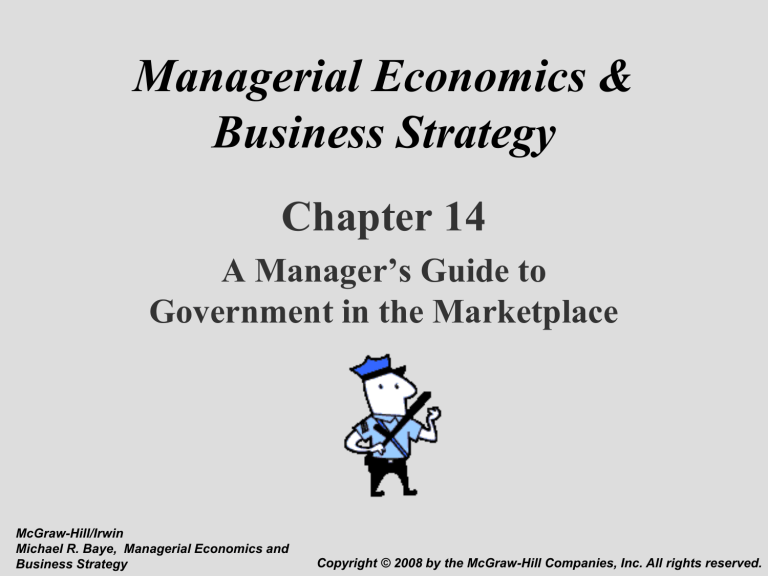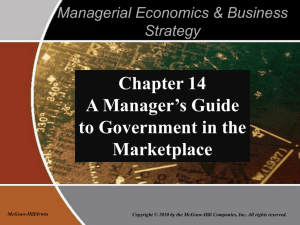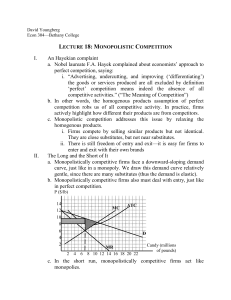
Managerial Economics &
Business Strategy
Chapter 14
A Manager’s Guide to
Government in the Marketplace
McGraw-Hill/Irwin
Michael R. Baye, Managerial Economics and
Business Strategy
Copyright © 2008 by the McGraw-Hill Companies, Inc. All rights reserved.
14-2
Overview
I. Market Failure
Market Power
Externalities
Public Goods
Incomplete Information
II. Rent Seeking
III. Government Policy and International Markets
Quotas
Tariffs
Regulations
14-3
Market Power
• Market power is the ability
of a firm to set P > MC.
• Firms with market power
produce socially inefficient
output levels.
Too little output
Price exceeds MC
Deadweight loss
P
Deadweight
Loss
MC
PM
PC
MC
• Dollar value of society’s
welfare loss
D
QM
QC
MR
Q
14-4
Antitrust Policies
• Administered by the DOJ and FTC
• Goals:
To eliminate deadweight loss of monopoly and promote
social welfare.
Make it illegal for managers to pursue strategies that foster
monopoly power.
14-5
Sherman Act (1890)
• Sections 1 and 2 prohibits price-fixing,
market sharing and other collusive
practices designed to “monopolize, or
attempt to monopolize” a market.
14-6
United States v. Standard Oil of
New Jersey (1911)
• Charged with attempting to fix prices of petroleum
products. Methods used to enhance market power:
Physical threats to shippers and other producers.
Setting up artificial companies.
Espionage and bribing tactics.
Engaging in restraint of trade.
Attempting to monopolize the oil industry.
• Result 1: Standard Oil dissolved into 33 subsidiaries.
• Result 2: New Supreme Court Ruling the rule of reason.
Stipulates that not all trade restraints are illegal, only those that are
unreasonable are prohibited.
• Based on the Sherman Act and the rule of reason, how do
firms know a priori whether a particular pricing strategy is
illegal?
14-7
Clayton Act (1914)
• Makes hidden kickbacks (brokerage
fees) and hidden rebates illegal.
• Section 3 Prohibits exclusive dealing
and tying arrangements where the
effect may be to “substantially lessen
competition.”
14-8
Cellar-Kefauver Act (1950)
• Amends Section 7 of Clayton Act.
• Strengthens merger and acquisition policies.
• Horizontal Merger Guidelines
Market Concentration
• Herfindahl-Hirschman Index: HHI = 10,000 S wi2
• Industries in which the HHI exceed 1800 are generally
deemed “highly concentrated”.
• The DOJ or FTC may, in this case, attempt to block a
merger if it would increase the HHI by more than 100.
14-9
Regulating Monopolies: MarginalCost Pricing
P
MC
PM
PC
Effective Demand
MR
QM
QC
Q
14-10
Problem 1 with Marginal-Cost
Pricing: Possibility of ATC > PC
P
MC
PM
ATC
PC
ATC
MR
QM
QC
Q
14-11
Problem 2 with Marginal-Cost
Pricing: Requires Knowledge of MC
P
Deadweight loss
after regulation
MC
PM
Deadweight loss
prior to regulation
PReg
Effective Demand
MR
QReg QM
Shortage
Q*
Q
14-12
Externalities
• A negative externality is a cost borne by
people who neither produce nor consume
the good.
• Example: Pollution
Caused by the absence of well-defined property
rights.
• Government regulations may induce the
socially efficient level of output by forcing
firms to internalize pollution costs
The Clean Air Act of 1970
Socially Efficient Equilibrium:
Internal and External Costs
P
Socially efficient equilibrium
MC external + internal
PSE
MC internal
PC
MC external
Competitive
equilibrium
D
QSE QC
Q
14-13
14-14
Public Goods
• A good that is nonrival and nonexclusionary in
consumption.
Nonrival: A good which when consumed by one
person does not preclude other people from also
consuming the good.
• Example: Radio signals, national defense
Nonexclusionary: No one is excluded from consuming
the good once it is provided.
• Example: Clean air
• “Free Rider” Problem
Individuals have little incentive to buy a public good
because of their nonrival & nonexclusionary nature.
14-15
Public Goods
$
Total demand for streetlights
90
54
Individual
Consumer
Surplus
MC of streetlights
30
18
0
Individual demand
for streetlights
12
30
Streetlights
14-16
Incomplete Information
• Participants in a market that have
incomplete information about prices,
quality, technology, or risks may be
inefficient.
• The Government serves as a provider of
information to combat the inefficiencies
caused by incomplete and/or asymmetric
information.
14-17
Government Policies Designed
to Mitigate Incomplete
Information
•
•
•
•
•
•
OSHA
SEC
Certification
Truth in lending
Truth in advertising
Contract enforcement
14-18
Rent Seeking
• Government policies will generally benefit
some parties at the expense of others.
• Lobbyists spend large sums of money in an
attempt to affect these policies.
• This process is known as rent-seeking.
An Example: Seeking
Monopoly Rights
• Firm’s monetary incentive to
lobby for monopoly rights: A
P
• Consumers’ monetary
incentive to lobby against
monopoly: A+B.
PM
• Firm’s incentive is smaller
than consumers’ incentives.
PC
• But, consumers’ incentives
are spread among many
different individuals.
• As a result, firms often
succeed in their lobbying
efforts.
14-19
Consumer
Surplus
A = Monopoly Profits
B = Deadweight Loss
A
B
MC
D
MR
QM
QC
Q
14-20
Quotas and Tariffs
Quota
Limit on the number of units of a product that a foreign
competitor can bring into the country.
• Reduces competition, thus resulting in higher prices, lower consumer
surplus, and higher profits for domestic firms.
Tariffs
Lump sum tariff: a fixed fee paid by foreign firms to enter
the domestic market.
Excise tariff: a per unit fee on each imported product.
• Causes a shift in the MC curve by the amount of the tariff
which in turn decreases the supply of all foreign firms.
14-21
Conclusion
• Market power, externalities, public goods,
and incomplete information create a
potential role for government in the
marketplace.
• Government’s presence creates rent-seeking
incentives, which may undermine its ability
to improve matters.







